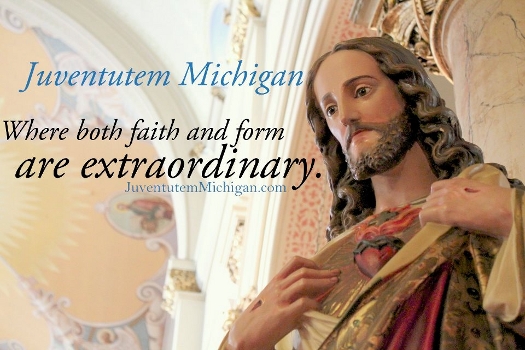
"I will go in unto the Altar of God
To God, Who giveth joy to my youth"
Tridentine Community News by Alex Begin (February 21, 2016):

February 21, 2016 – Second Sunday of Lent
Archdiocese of New York Issues New Norms for Sacred Art
Following on the heels of the Diocese of Marquette, Michigan’s recent document concerning norms for sacred music, the Archdiocese of New York has recently published its own document establishing standards for sacred art that may be commissioned for its churches. Entitled “Guidelines for the Commissioning and Care of Sacred Art”, the document makes several praiseworthy points:- Sacred art must elevate the mind and soul to things divine.On a practical level, a document such as this is needed at many parishes, where volunteers and parish council members can benefit from an introduction to the sorts of responsibilities associated with selecting, acquiring, and maintaining sacred objects. We cannot blame people for poor artistic choices or careless maintenance if they have not been educated in the first place.
- Devotional Art, such as paintings and statues, edifies the faith of the individual. Liturgical Art, such as vestments and altars, has a functional as well as inspirational purpose.
- Sacred vessels such as ciboria and chalices must be made of metal. Glass and earthenware vessels are prohibited.
- “Symbols depicted on vestments should be expressive of sacred realities.” No bland or secular images should be used.
- Sacred art should be blessed before being put into use.
- Donations of sacred art are only to be accepted if they meet the same standards as commissioned art.
- “An inventory of those vestments which have significant artistic or historical value should be kept in both the parish and diocesan archives.” In other words, historic vestments should not be casually discarded if no longer deemed suitable to a parish’s needs.
- An appendix details “The Care and Cleansing of Altar Linens”
- Repeated emphasis is made that sacred art which is no longer needed and cannot be sold or given to a suitable new owner should be burned or buried, not simply thrown away.
The document is available at: http://nyliturgy.org/wp-content/uploads/2016/01/nyguidelinesforsacredart.pdf
Lenten Liturgical Quirks
You may have noticed a few changes to the format of the Mass during Lent. Some are obvious: The Glória is suppressed, and the Alleluia is replaced by a Tract. The overall purpose of these modifications is to restrain the usual jubilance in the Mass.
It so happens that the Tract is only provided on Sundays, Mondays, Wednesdays, and Fridays. The Gradual alone is used on Tuesdays, Thursdays, and Saturdays.
No unaccompanied organ is permitted during Lent, except on Lætáre Sunday, the Fourth Sunday of Lent. That means no Prelude, Postlude, or Elevation (instrumental piece after the Consecration) may be played. The organ may only be used to accompany singing.
Unlike most other Ferial Masses, when the Mass is a repeat of the previous Sunday’s Mass, the Ferias of Lent are unique. There are specific Propers for, for example, Tuesday in the Second Week of Lent. Lenten [and Advent] Ferias are Third Class, so only higher ranking Saints’ Feasts like St. Joseph on March 19 can displace them. When there are lesser Saints on the calendar, they are commemorated via a second Collect, Secret, and Postcommunion Prayer after the Ferial Mass’ ones. That takes place this coming Tuesday, February 23, for example, when St. Peter Damian is commemorated.
After the Postcommunion Prayer at weekday Feria Masses, there is a Prayer Over the People. It begins with the celebrant asking the faithful to bow their heads. This tradition has been carried over to the Ordinary Form, as well.
Louisiana Bishop Espouses the Traditional Mass
It’s always good news to learn of bishops who embrace the Extraordinary Form. Bishop Glen Provost of the Diocese of Lake Charles, Louisiana is one such Ordinary. On December 30, 2015, Bishop Provost celebrated his eleventh Solemn Pontifical Mass in the Extraordinary Form, at the Cathedral of the Immaculate Conception. By comparison, there have only been three Solemn Pontifical Masses in our region over the past eleven years, one celebrated by Bishop Carl Mengeling at All Saints Church in Flint in 2005, one by Chicago Auxiliary Bishop Joseph Perry at St. Josaphat Church in 2010, and one by then-Bishop of Marquette Alexander Sample at Assumption Grotto in 2012. A Solemn Pontifical Mass is far more elaborate than the Missa Cantatas that local bishops usually celebrate, thus it is all the more impressive that Bishop Provost is setting such a laudable if unpublicized example with this complex liturgy in his own diocese. It might not surprise our readers that vocations are strong in the Diocese of Lake Charles, and that many young priests are offering the Tridentine Mass. (Source: www.newliturgicalmovement.org)
Tridentine Masses This Coming Week
- Mon. 02/22 7:00 PM: Low Mass at St. Josaphat (Feria of Lent)
- Tue. 02/23 7:00 PM: High Mass at Holy Name of Mary (Feria of Lent)
- Fri. 02/26 7:00 PM: High Mass at Old St. Mary, Detroit (Feria of Lent) – Celebrant: Fr. Stephen Pullis, Priest Secretary to Archbishop Vigneron. Music by Wassim Sarweh and the choir of Windsor’s St. Benedict Tridentine Community. Stations of the Cross at 6:15 PM. Juventútem Michigan will host a dinner for young adults age 18-35 after Mass in the Parish Hall.


No comments:
Post a Comment